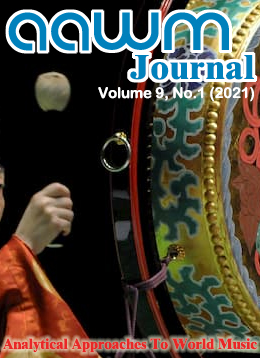 |
|
 |
 |
 |
 |
 |
|
AAWM JOURNAL Volume 9, No. 1 (2021) |
 |
 |
| Volume 9, No. 1 (2021) |
|
 |
 |
| Tonic, Final, Kyū: Tonal Mappings in the Meiji Period and Beyond |
| Liam Hynes-Tawa |
|
This article discusses the state of music theory in late-nineteenth- and early-twentieth-century Japan, where musicians were invested in finding ways to map theories of traditional Japanese music and those of European tonality onto each other. By focusing on two theorists from the late nineteenth century (Isawa Shūji and Uehara Rokushirō) and one from soon after World War II (Koizumi Fumio), I demonstrate the coexistence of many contradictory ways of analyzing much of the music that came out of this period and afterward. My analysis of their various types of mapping draws out the cultural implications and goals that lie behind their strategies, which reflect the different ways in which they were hoping to situate Japanese music in a wider global context, whether as part of nineteenth-century nation-building or postwar reemergence.
Through analysis of several pieces written between the early twentieth and early twenty-first centuries, I suggest that the most effective lens is one that freely borrows elements from various theorists and traditions to create analyses that are as hybridized as the pieces themselves. Examples are drawn from a wide variety of genres—children’s songs, wartime soldiers’ songs, enka (nostalgic popular music), and film music—to demonstrate the wide reach of these hybridized tonal systems. By extension, analogous models could also be applied to musical traditions elsewhere in the world that blend Western tonal and non-Western elements.
|
| Petar Ralchev’s “Bulgarian Suite”: Explorations of Asymmetry, Modality, and Metrical Dissonances |
| Kalin Kirilov |
|
The music of Bulgaria is an excellent example of a complex musical tradition which combines Middle Eastern makams (modes), regional microtonal structures, pentatonic scales, diatonic modes, and major/minor collections. This article analyzes “Bulgarian Suite,” an accordion piece written by the living Bulgarian composer Petar Ralchev. “Bulgarian Suite” is a trend-setting piece incorporating mixed asymmetrical meters, modal harmony, dense ornamentation, improvisation, folk motives from various regions of Bulgaria, and influences from Western music styles. Stylistically, “Bulgarian Suite” exemplifies Bulgarian concert wedding music from the 1990s, which became popular worldwide through the performances of Ivo Papazov and his Trakiya (Thrace) orchestra.
The analysis of “Bulgarian Suite” focuses on Ralchev’s compositional techniques and his innovative approaches to combined metric groups (several asymmetrical meters recurring periodically), heterometric rows (meters which do not follow a particular pattern), and modal/makam-based harmony. Ralchev’s primary compositional idea in “Bulgarian Suite” is to establish balanced asymmetry at the beginning of the piece and gradually progress towards more traditional and symmetrical structures. Due to the improvisatory nature of Bulgarian wedding music, “Bulgarian Suite” should not be considered a fixed composition. Rather, as seen from other recordings of the same piece, Ralchev uses the suite structure as a flexible framework that is varied to a great extent in different performances.
In addition to analyzing and adapting Western analytical tools to a particular non-Western piece, this article also introduces a new, comprehensive model of inquiry which could be applied to repertoire from other Eastern European countries exhibiting levels of metric and harmonic complexity similar to those found in Ralchev’s “Bulgarian Suite.”
|
| Do Ko Gyi Kyaw: Analyzing the Interactions between Rhythms, Melodies, and Sonic Structures of a Burmese Spirit Song Performance |
| Lorenzo Chiarofonte |
|
Ko Gyi Kyaw is one of the most revered nats (spirits) in Burma (Myanmar), and the dance of this powerful spirit, who is considered to be a womanizer and a drunkard, is one of the most anticipated moments in a nat kana pwe (private spirit ceremony). At particular moments during a pwe, the devotees join the dances, calling and embodying, among others, the nat Ko Gyi Kyaw. While indulging in the consumption of alcohol and cigarettes, they experience the presence of the spirit: supported by the intense music of the nat hsaing (drums and gongs ensemble), they dance to the sound of many nat chins (spirit songs), celebrating the drunkard nat. This paper investigates the performance of a popular spirit song, Do Ko Gyi Kyaw. Focusing on a particular performance by the Kyi Lin Bo’s nat hsaing ensemble from Yangon, the paper discusses the performative strategies adopted by the musicians to interact with the possessed dancers. Through different analytical strategies and transcription methodologies, and drawing on the discourse of the performers themselves, this paper reveals the function and meaning of the ritual sounds; it analyzes how the structural elements of the song Do Ko Gyi Kyaw are adapted to the performance of the ritual dances. Looking at the song’s vocal and melodic elaboration, rhythmic interlocking, metric expansion/contractions, and changes in tempo/dynamics, this paper discusses how the hsaing sounds contribute to triggering, supporting, and controlling the spirit possession dances of the devotees, making the nat Ko Gyi Kyaw come into presence.
|
| The Brimming Vessel: An Analysis of the Ritual Repertoire of the Miḻāvu from a Tantric Perspective |
| Paolo Pacciolla |
|
The miḻāvu is a huge pot drum that was, until a few decades ago, exclusively associated with Kūtiyāṭṭaṃ Sanskrit theater. Its history, language, and repertoire have been fashioned upon the performance of Kūtiyāṭṭaṃ dramas enacted in Brahmanical temples of Kerala for the
exclusive benefit of a privileged elite. During several centuries of association with these temples where rituals were performed according to Tantric procedures, Kūtiyāṭṭaṃ was heavily charged with ritual elements.
Due to these audience restrictions, Kūtiyāṭṭaṃ remained almost unknown to the rest of the world until the 1960s, when radical political changes produced a revolution in the social organization of Kerala that had a significant impact on this theatrical art form and temple arts in general. A new phase in the history and evolution of the art started in 1965, when a department of Kūtiyāṭṭaṃ was introduced at the dance and theater academy Kerala Kalamandalam. There the art of Kūtiyāṭṭaṃ was redefined and refined and then recognized, in 2001, as a World Intangible Cutlural Heritage by UNESCO.
Today, Kūtiyāṭṭaṃ is a highly complex art form that includes elements and procedures inherited from the ancient Sanskrit theatrical tradition—adjusted to meet and suit the needs and likes of contemporary audiences—as well as elaborated rituals maintained with unquestioning respect. In fact, the sequence of ritual music and dance compositions (puṟappāṭu) introducing dramas is generally considered meaningless by contemporary performers, and almost none of them acknowledge the contribution of Kerala Tantric tradition to it. Contrasting with the performers’ view, the analysis of musical and visual content of the ritual compositions of the miḻāvu shows that they are heavily imbued with Tantric concepts. On the basis of the cluster of ideas, symbols, stories, and rites that have been associated in the Brahmanical temple tradition of Kerala with the miḻāvu and its ritual compositions as well as with the ritual songs and dances preceding the drama, this essay suggests a novel interpretation of the entire puṟappāṭu sequence, arguing that it is a symbolical re-enactment of a sonic cosmology according to Tantric theories.
|
|
|
 |
|
 |
 |
|



